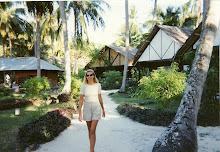Along with hundreds of thousands of others, some neighbours here were stuck in Boston after the unpronounceable Icelandic volcano exploded into the skies, dusting European airspace with volcanic ash.
The day after French and other European and UK fights were grounded, I opened my door here in the forest to a haze of yellow dust. Just another natural phenomenon - the breeze blowing clouds of pollen from pine tree branches into the warm spring air. My blue car was yellow. My terrace was yellow. My Burmese/Siamese cat, Coco, was yellow. After a short walk in the garden my shoes and jeans were yellow. Last year there was a shower after the heaviest pollen clouds. Pollen lay everywhere like mustard for days.
It's also the time of year when ants get active. They come in three sizes: giant, middling and tiny. The big ones stay around dead trees in the forest. Don't know quite what the little ones get up to. It's the middle-sized ants, the carpenter ants, that are troublesome. They troop into the house, climbing the exterior wall and entering through any little opening and nest in the wooden beams. Bit by bit, they hollow out the beams, pushing wood dust out. They're eating my house. I like most creatures and generally go out of my way to avoid hurting them. But I have to make an exception with the ants. I buy that ant killer that says the ants find it irresistible and take it into the nest where they all have a good meal then die. It's utter rubbish. They make huge detours to avoid the stuff. I'm just 're-roofing' the frame over the terrace with mesh so I can plonk all the honeysuckle back over it and while I was up the ladder I saw legions of ants trundling over the frame, waving their antennae in greeting at one another, on their way to eat my beams. You can brush them off but they just start again at the bottom.
While I was up the ladder a neighbour arrived with his station wagon. "Viens voir" he said, calling me over.
In the back seat he had a miniature goat with miniature horns and a very sweet face.
"I know you like animals" he said. "So I thought I'd bring this one to show you. There were two, loose by the canal. The other one got away. I think they belong to Gregory, your neighbour."
No I said. Gregory has sheep and donkeys and geese and hens and cats and dogs and children. But no goats.
We looked at the goat in the back seat. He looked back at us. Since he wasn't the slightest bit scared I suddenly thought he must live at the pony school. The pony school along the track has a bunch of tiny ponies ridden by tiny riders, all little girls who love ponies. Every day they ride past the house on the track, led by an older girl or a big bloke on a more substantial horse. Maybe the school also kept goats. That would explain why the goat was used to humans.
My neighbour duly drove the goat to the pony school. No, not ours, they said. But we'll keep him till you find the owners.
Asking around, another neighbour, Daniel, did indeed know who owned the two goats. My neighbour called round and told the family 'I found one of your goats.'
They were delighted, a couple and a troop of young kids. (Not a pun.)
The goats were not tethered they explained. They just wander about all day and come home in the evening. This was the first time in six months that they'd wandered so far.
Everyone went to the school to collect the first goat.
The second arrived at my neighbour's house later that day, perhaps scenting that her partner had already turned himself in.
Goats and family were reunited.
Once that was all dealt with I turned my attention to the oyster shells. I'd invited friends to eat oysters at my place the previous night as the guy who sells oysters in the local market sells the world's best oysters. From Bouzigues, he's a young guy, clearly very proud of his work and the quality of his oysters. Last week I told him I'd found a small blue pearl in one of the oysters I'd bought from him and he explained that yes that can happen but it's rare. Also, because the oysters are young, the pearls are soft and not mature. That had been obvious as the outer layers crumbled easiy. Still, it was the first time I'd found a pearl in my dinner.
Anyhow, I had dozens of oyster shells. More than I'd paid for because oyster sellers work on the old 13 to a dozen principle. Looking at them, they were so beautiful I couldn't throw them away. Maybe they'd make good compost? Looking online it seemed that they do indeed make good compost. I was about to start hammering them to smithereens when my neighbour called round again. He'd done a deal with the woman at the pony school, exchanging our collective olive oil for her horse manure mixed with straw. Did I want to be included so I could have fertiliser for my olive trees? Yes please.
"However" I said proudly "I'm also making oyster shell compost".
He looked at me as if I was mad.
"It's full of calcium" I said. "Very good for the soil."
He threw his head back and laughed.
Yes it's full of calcium he replied. But not good for your soil. Look around - your soil is calcaire - it's made of calcium."
OK. I'll stick with the horse manure.
Sunday, April 25, 2010
Subscribe to:
Post Comments (Atom)

No comments:
Post a Comment